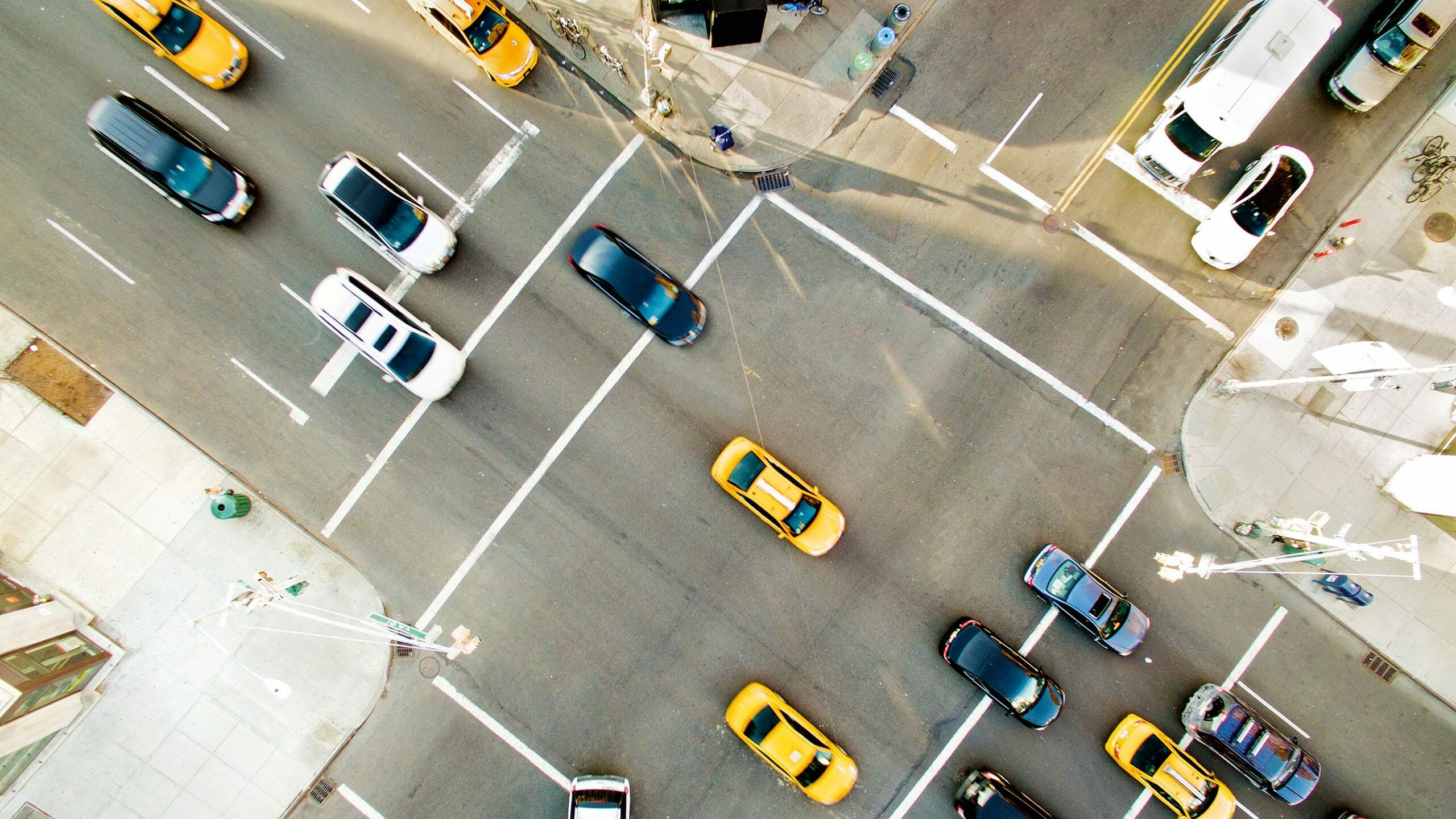Autonomous driving - Level 5.
Level 5 is the highest degree of automation of motor vehicles
that allows driverless participation in traffic. To reach this level,
deep-learning computers are taught the correct behavior in
many road traffic situations as if they were children. Within a
short period of time, incredible progress has been made in this
field with car computers that are no larger than eight soda cans
put together. Is autonomous driving really still a futuristic fantasy?
Autonomous driving was the topic of the last BECHEM International
Automotive Meeting in Berlin and at the second Treffpunkt Automotive Ruhr, a business initiative of automotive suppliers, in which BECHEM is involved.
The service car of a sanitation company drives onto a construction site – all by itself. Workers take the parts they had ordered (via a smartphone) out of the vehicle. A little later, one of the technicians is picked up by a self-driving car and taken to the next construction site. Pure fiction. When will level 5 come true?
Social attitudes towards mobility are changing. This is due to mega trends such as the increasing environmental awareness in all parts of the population and the digitalization of many areas of life. It is accelerated by an advancing shortage of resources, a higher work density, the debate surrounding CO2 and climate change. The congested traffic infrastructures in larger cities reinforce this trend alongside higher mobility requirements in the family and workplace, frequently coupled with smaller budgets. Young people today have a less emotional relationship to cars. What was still considered a major status symbol 20 years ago has become an object of utility: rational use is more important than possession. These changing values lead to entirely new mobility concepts and user profiles. Carsharing, electromobility, bike rental systems, services such as Uber and, ultimately, their interconnection with other means of transport are becoming increasingly significant. At the same time, social acceptance of diesel engines is waning. Existing and planned traffic concepts in metropolises such as London, Oslo and Paris intensify and accelerate this paradigm shift with restrictions on or compensation fees for environmental pollutants.
Considering the burden on traffic and the work involved in driving, many users will be more than happy to give away their steering wheel. Functionality and connectivity versus speed and horsepower. When will vehicle developers reach level 5? Level 5, the automation level of vehicles that can drive themselves without human intervention.
Recreated occupancy grid – how on-board supercomputers represent available traffic areas.
When it comes to evidence for these tendencies in everyday life, opinions vary widely: estimates for the realization of level 5 range from a pessimistic 30 years to a somewhat ambitious three. Legal obstacles, ethical aspects and accidents, i.e. the state of the technology, are cited as reasons for delays. But many autonomous driving functions are already available in serial vehicles – some more obvious, some less. Certain vehicles that are equipped for autonomous driving (or comprehensive function upgrades) have been approved for use on test routes or as test vehicles for field trials in US states. This is reflected in a range of upmarket mid-range models and self-driving taxis in an American metropolis. The combination of AI computer platforms, map data, traffic information and localization data determined by sensors and camera systems makes this technological leap possible: it generates a dynamic, three-dimensional picture of the vehicle and its environment. These super computers work with deep-learning processes, meaning that they learn the behavior of the driver and all other road users through observation as a “passenger”. Ultimately, they will be able to interpret the intentions of road users with reliable accuracy. On the way to that final stage, the developers continuously delete learned misbehavior and replace it with better behavior provided by other AI systems.
Legal experts have identified complex legal obstacles for the development of partially automated, highly automated and fully automated vehicles and autonomous driving systems in German and European road environments. Who is driving: the human or the machine? Does the parts manufacturer assume liability for product faults that cause accidents? Manufacturers have a duty to instruct; drivers have a duty to monitor the products. The situation is further complicated by issues of ethics and data protection.
The highly automated, virtually self-driving vehicles currently on the market also include well-known electric cars. These models clearly document the transition to alternative drive concepts. One manufacturer counteracts infrastructural shortcomings by operating its own charging stations, thus creating its own sales market. Perhaps, the less motorized economies will be able to contribute decisive developmental impulses in the transition to electromobility and autonomous driving: these countries are very likely to skip the stage of combustion engines in the mass motorization process. They will be able to base their infrastructural development on entirely new benchmarks – the requirements for self-driving vehicles – as many places will be starting from scratch.
Stages of automated driving
(level 0 – level 5)
Only the driver operates the vehicle.
Individual assistance systems support the driver in operating the vehicle (e.g. speed or distance regulators).
Partial automation. Includes automatic parking, lane-keeping assistant, automatic acceleration and deceleration.
High automation. The vehicle additionally controls lane keeping/switching and turn signals. The assistant recognizes
borderline cases and prompts the driver to operate the vehicle.
Full automation. The system operates the vehicle constantly. In borderline cases, the driver can override the
system at any time.
The system can master any situation that occurs during any journey automatically.
Did you know?
80% - 90%
Humans are the weak point of any autonomous driving system with an 80–90% rate of incorrect interventions.
Three years or 30?
When will autonomous driving become reality? Current estimates predict a development period between three and thirty years.
Precision.
There are considerable differences between navigation and autonomous driving in terms of precision. Navigation systems have an accuracy of up to five meters only, while autonomous driving systems can achieve an accuracy of less than 10 cm.
Road and environment information are transmitted live for autonomous cars, while navigation systems use data that is at least three months old.
8 TeraFLOPs
is the performance of the current state-of-theart super computer platform for cars. This corresponds to the computing power of 150 Mac-Book Pro laptops.
Fully automatic mobility for humans and goods?
Interview with Dr.-Ing. Roger Müller, Managing Director of Logiball GmbH, Herne.
Carl. At the last Treffpunkt Automotive Ruhr, an event organized by Wirtschaftsförderung metropoleruhr GmbH, you contributed a lecture on the topic of autonomous driving. Your company specializes in engineering navigation maps and solutions in the B2B segment. Can you elaborate on this?
For more than 20 years, Logiball has been working on maps and their use in the field of mobility for the B2B sector. This ranges from navigation solutions for special applications, e.g. the global market leader in the field of agricultural machinery, to quality assurance of map data used by car manufacturers for autonomous driving. We developed from a former spin-off of a Fraunhofer Institute to one of the world’s few specialists in this field, which places us in close proximity to the state of innovation.
Carl. According to a statement on your website, you believe that human and machine mobility will be able to take place on a fully automatic level in the foreseeable future. Many voices in the media claim the opposite. Do you have a comment?
Allow me to refer to the development of the iPhone. Up until one month before the first iPhone was released in 2007, many experts thought it impossible that such a thing could exist. They had a lot of valid reasons: batteries and mobile
networks were not powerful enough, and no mobile telephone could do without a keyboard. Today’s arguments against the electric robo-taxi remind me of those reasons. In 2016, Google was able to drive an average distance of 8,000 kilometers fully automatically before any human intervention became necessary. This was an improvement by the factor of five in comparison to 2015, and GM has already announced that it will launch a test fleet of several thousand autonomous robo-taxis in 2018. The relevant technologies are currently being developed at such a rapid speed that I personally believe we will have access to regular robo-taxi services in some cities within four years at most. Perhaps not in Germany, but certainly in East Asia and the US.
Carl. What is currently obstructing the relevant developments? The legal framework?
No, the legal framework will adapt; I think this discussion is exaggerated. Reliable sensors at an affordable price are a major concern: the “eyes” of an autonomous vehicle are what makes or breaks it. All other necessary components – super computers for the trunk, deep learning, 5G networks, big-data infrastructure, high-resolutions maps – are well under way. There has been massive progress with the sensors, too. A lot of hopes are pinned on semiconductor-based LiDAR
(light detection and ranging) technologies at the moment. Those systems will be able to recognize all obstacles around the vehicle in real time without any mechanical components – at a price that is a hundred times lower than that of currently available LiDAR systems. This will ultimately make it possible to lower the price per kilometer for the end user to the one-digit cent range, which is a crucial goal. And that is when our world will really change: at the moment, few individual means of transport have a kilometer price of less than 30 cent.
Carl. What about accidents caused by glare, reflective surfaces or sunlight, such as the high-profile case involving a white truck in the US?
That is the risk aspect: autonomous driving is a risk. Even though the likelihood of an accident is statistically considerably lower than it is with a human behind the steering wheel. Providers of autonomous mobility solutions will be extremely reluctant to take this risk. Proof that the autonomous vehicle did not do anything wrong and, on top of that, reacted considerably better than the human driver, will not change this: the risk of jeopardizing the brand is simply too high. Great effort goes into the minimization of risk.
But there are solutions for this problem, too. You could, for instance, open or close roads to autonomous vehicles using a highly dynamic system. This would involve determining the likelihood of accident during autonomous driving in every single second and closing the road if the risk is too high. The closures would be marked on a map and transferred to the vehicle, which considers the closure when calculating its route. Countless factors determine whether a road should be opened or closed: when the sun is low, glare can compromise the function of the camera systems, for instance. I explained in my demonstration during the conference how our ADRIA system determines this precise risk factor – sun glare – in addition to many others for every single road in the world in order to decide whether a road should be closed.

Dr.-Ing. Roger Müller, Managing Director/ CEO of Logiball GmbH, Herne.
Other topics
Nothing found.

